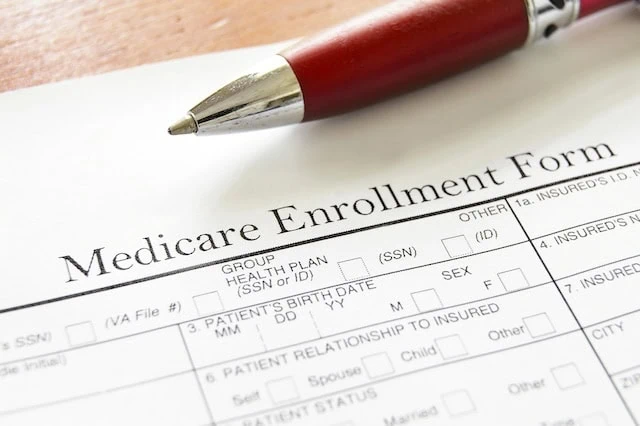While Medicare is of enormous value to the millions of Americans who use it, it’s a complex program—and people can sometimes face stiff financial consequences for getting it wrong.
In fact, you can walk across one of Medicare’s biggest potential landmines before you ever even use it: late enrollment penalties.
Medicare provides several types of enrollment periods. Sign up for your coverage on time, and you’re fine. Sign up late, however, and you could face penalties—some of which can last for the rest of your life.
Today, I’m going to show you how to avoid Medicare’s late enrollment penalties. I’ll start by explaining the three major Medicare enrollment periods, then I’ll break down the penalties you could face if you’re late in enrolling for each of the Medicare “Parts.” By understanding the deadlines and consequences of late enrollment, you can ensure a smooth transition into Medicare coverage without unnecessary financial burdens.
What Is the Medicare Initial Enrollment Period?

Your Medicare Initial Enrollment Period (IEP) is when you first become eligible to sign up for Part A and Part B. It’s a seven-month period that revolves around your 65th birthday:
- The three months before the month in which you turn 65
- The month in which you turn 65
- Three months after the month in which you turn 65
Example: If your birthday is Aug. 15, your IEP would begin May 1 and end Nov. 30.
However, if your birthday is on the first of the month, your IEP starts four months before your birthday, but ends two months after your birth month.
Example: If your birthday is Aug. 1, your IEP would begin April 1 but end Oct. 30.
Do you want to get serious about saving and planning for retirement? Sign up for Retire With Riley, Young and the Invested’s free retirement planning newsletter.
What Is the Medicare Special Enrollment Period?

In some situations, people qualify for a Special Enrollment Period (SEP) that allows them to sign up for Part B and Premium-Part A (when Part A coverage requires a premium) without paying a late enrollment penalty.
Some of the situations that might qualify a person for a Special Enrollment Period include:
- Losing Medicaid coverage
- Missing the opportunity to sign up because you (or an authorized representative, guardian, or caregiver) were impacted by a natural disaster or declared emergency
- Missing the opportunity to sign up because of inaccurate or misleading information from an employer or health plan
- Missing the opportunity to sign up while you were incarcerated
- Missing the opportunity to sign up because of exceptional conditions (requires contacting Social Security to ask for a Special Enrollment Period)
- Having or had health insurance through your or your spouse’s employer (or a family member’s employer if you have a disability and they had a large group health plan)
- Volunteering and serving in a foreign country
- Having TRICARE
I also want to point out a few situations that don’t qualify you for a SEP, which include (but aren’t limited to):
- COBRA coverage or retiree coverage ending
- Missing your sign-up window when you stopped working or lost employer-based coverage
- Having or losing Marketplace coverage
- Having End-Stage Renal Disease (ESRD) (Learn more about ESRD Medicare coverage)
A Special Enrollment Period is temporary. The length of the SEP varies depending on the triggering event but is often either six or 12 months. If a person fails to sign up within the allotted time frame, they’ll have to wait for the next General Enrollment Period and might need to pay a monthly late enrollment penalty.
What Is the Medicare General Enrollment Period?

Anyone who missed their Initial Enrollment Period and doesn’t qualify for a Special Enrollment Period can still sign up for Medicare during the General Enrollment Period (GEP).
The GEP runs from Jan. 1 through March 31 of each year.
Unfortunately, signing up during the General Enrollment Period without qualifying for a Special Enrollment Period could result in being assessed a monthly late enrollment penalty.
Related: Here’s How You Can Lose Medicare [And How You Won’t]
Late Enrollment Penalties

Late enrollment penalties are added to your monthly premium. However, despite what the term might suggest, these penalties are not one-time fees—they’re usually paid in the form of a higher premium. How much you pay, and how long you pay it, depends on how late you were to sign up.
Let’s look at the penalty breakdowns for Parts A, B, C, and D.
Related: Medicare FAQs: Your Questions Answered
Part A Late Enrollment Penalty

Generally, Medicare Part A helps cover the costs of inpatient care you get in hospitals, critical access hospitals, and skilled nursing facilities. Additionally, it helps with expenses for hospice care and some home health care.
Most people qualify for premium-free Medicare Part A. However, some people need to buy it regardless of when they signed up. If you are one of the people who need to purchase Part A, don’t do so during your Initial Enrollment Period, and don’t qualify for a Special Enrollment Period …
- Your penalty may be an increase of 10% to your monthly premium.
- You would need to pay that penalty for twice the number of years you didn’t sign up on time.
Example: If you signed up one year late, you may need to pay a 10% higher premium for two years.
Related: ‘Original Medicare’ Doesn’t Cover Everything: Here’s What It’s Missing
Part B Late Enrollment Penalty

Medicare Part B helps pay for medically necessary services or supplies and preventative services.
If you don’t sign up for Part B on time (and don’t qualify for a Special Enrollment Period) …
- Your penalty may be an increase of 10% to your monthly premium for every full 12-month period you could have signed up for Part B but didn’t.
- You generally will pay this penalty for as long as you’re on Medicare.
Example: If you failed to sign up for Part B for three full years, your penalty would be a 30% monthly premium increase. The 2025 Part B standard premium was $185. Your penalty would be 30% of that amount, or $55.50. Add that to the standard premium, and you would pay $240.50 for 2025. (Note: Amounts are rounded to the nearest 10¢.)
Also keep in mind that premiums might be higher than the standard amount, depending on your income.
Related: Health Care Costs in Retirement [Amounts & Types to Expect]
Part C Late Enrollment Penalty

Medicare Part C, also known as Medicare Advantage, is the name given to private-provider Medicare plans. Part C plans offer Part A and B coverage, and usually Part D prescription coverage as well.
Part C plans do not have late enrollment penalties. However, because enrollment in Part A and Part B are required for Part C enrollment, and because you still pay Parts A and B premiums while on Part C, you’ll still have to pay applicable Parts A and B penalties if you opt for a Medicare Advantage plan.
Part D Late Enrollment Penalty

Medicare Part D helps cover the costs of brand-name and generic drugs. It’s optional and offered to people with Medicare by insurance companies as well as other Medicare-approved private companies.
If you don’t join a Medicare drug plan when you initially get Medicare, or if you go 63 days or more without creditable drug coverage (prescription drug coverage that’s expected to pay at least as much as Medicare drug coverage) …
- Your penalty may be an increase of 1% to your monthly premium for every month in which you were eligible but waited to join a Medicare drug plan and didn’t have creditable drug coverage.
- You generally will pay this penalty for as long as you’re on Medicare.
The penalty is based on the “national base beneficiary premium,” which changes every year, meaning the penalty amount also changes every year.
Example: If you waited 15 months after becoming eligible for Medicare (and didn’t have creditable drug coverage) to sign up for Part D, you would need to pay a 15% late enrollment penalty on top of your monthly plan premium. The 2025 national base beneficiary premium was set at $36.78. If someone enrolled in 2025 after waiting 15 months past when they could have first gotten Medicare, the penalty would be 15% of $36.78. That comes out to $5.517, but amounts are rounded to the nearest 10¢, so the penalty would be $5.50 per month. Your premium for 2025, then, would be $42.28 per month.
Like with Part B, premiums might be higher than the set standard, depending on your income.
Remember: You generally will not be charged a Part D penalty if you have creditable drug coverage or qualify for Extra Help. MA-PDs, which are Medicare Advantage plans with prescription drug coverage, count as creditable drug coverage.










